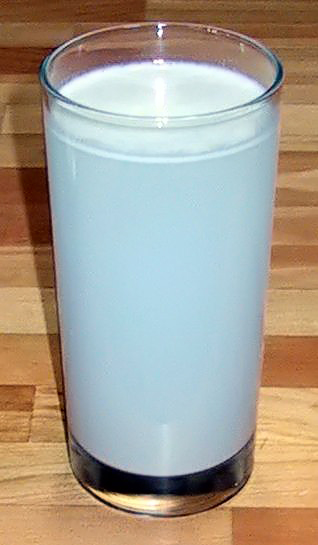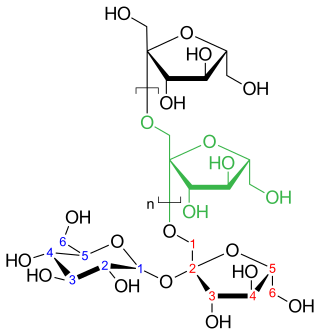
A colloid is a mixture in which one substance consisting of microscopically dispersed insoluble particles is suspended throughout another substance. Some definitions specify that the particles must be dispersed in a liquid, while others extend the definition to include substances like aerosols and gels. The term colloidal suspension refers unambiguously to the overall mixture. A colloid has a dispersed phase and a continuous phase. The dispersed phase particles have a diameter of approximately 1 nanometre to 1 micrometre.
An emulsion is a mixture of two or more liquids that are normally immiscible owing to liquid-liquid phase separation. Emulsions are part of a more general class of two-phase systems of matter called colloids. Although the terms colloid and emulsion are sometimes used interchangeably, emulsion should be used when both phases, dispersed and continuous, are liquids. In an emulsion, one liquid is dispersed in the other. Examples of emulsions include vinaigrettes, homogenized milk, liquid biomolecular condensates, and some cutting fluids for metal working.

In chemistry, a suspension is a heterogeneous mixture of a fluid that contains solid particles sufficiently large for sedimentation. The particles may be visible to the naked eye, usually must be larger than one micrometer, and will eventually settle, although the mixture is only classified as a suspension when and while the particles have not settled out.

Lecithin is a generic term to designate any group of yellow-brownish fatty substances occurring in animal and plant tissues which are amphiphilic – they attract both water and fatty substances, and are used for smoothing food textures, emulsifying, homogenizing liquid mixtures, and repelling sticking materials.

Xanthan gum is a polysaccharide with many industrial uses, including as a common food additive. It is an effective thickening agent, emulsifier, and stabilizer that prevents ingredients from separating. It can be produced from simple sugars by fermentation and derives its name from the species of bacteria used, Xanthomonas campestris.

In colloidal chemistry, flocculation is a process by which colloidal particles come out of suspension to sediment in the form of floc or flake, either spontaneously or due to the addition of a clarifying agent. The action differs from precipitation in that, prior to flocculation, colloids are merely suspended, under the form of a stable dispersion and are not truly dissolved in solution.

Easy Cheese is the trademark for a processed cheese spread product distributed by Mondelēz International. It is also commonly referred to by generic terms such as "spray cheese", "squirt cheese" or "cheese in a can". Easy Cheese is packaged in a metal can filled with air covered with a plastic cap that reveals a straight, flexible nozzle where the cheese is extruded.

Mouthfeel refers to the physical sensations in the mouth caused by food or drink, making it distinct from taste. It is a fundamental sensory attribute which, along with taste and smell, determines the overall flavor of a food item. Mouthfeel is also sometimes referred to as texture.

A fructan is a polymer of fructose molecules. Fructans with a short chain length are known as fructooligosaccharides. Fructans can be found in over 12% of the angiosperms including both monocots and dicots such as agave, artichokes, asparagus, leeks, garlic, onions, yacón, jícama, barley and wheat.
A dispersion is a system in which distributed particles of one material are dispersed in a continuous phase of another material. The two phases may be in the same or different states of matter.

Basil seed is the general term used to refer to the seeds of a few species of herb plants (basil). Generally, these seeds are small, black with a mild, nutty flavor and gel-like texture when soaked in water for 15 minutes.

Nanocellulose is a term referring to nano-structured cellulose. This may be either cellulose nanocrystal, cellulose nanofibers (CNF) also called nanofibrillated cellulose (NFC), or bacterial nanocellulose, which refers to nano-structured cellulose produced by bacteria.
QimiQ is a dairy product consisting of 99% light cream and 1% gelatine. It is patented by HAMA Foodservice GmbH.
Polyelectrolytes are charged polymers capable of stabilizing colloidal emulsions through electrostatic interactions. Their effectiveness can be dependent on molecular weight, pH, solvent polarity, ionic strength, and the hydrophilic-lipophilic balance (HLB). Stabilized emulsions are useful in many industrial processes, including deflocculation, drug delivery, petroleum waste treatment, and food technology.

Helen Frances Gleeson OBE FInstP is a British physicist who specialises in soft matter and liquid crystals. She is Cavendish Professor and former Head of the School of Physics at the University of Leeds.

Arthrospira platensis is a filamentous, gram-negative cyanobacterium. This bacterium is non-nitrogen-fixing photoautotroph. It has been isolated in Chenghai Lake, China, soda lakes of East Africa, and subtropical, alkaline lakes.

María Guðjónsdóttir is a professor of food science at the University of Iceland.
Stefan A. F. Bon is a Professor of Chemical Engineering in the department of Chemistry at the University of Warwick, United Kingdom. His research considers polymer-based colloids. He is a Fellow of the International Union of Pure and Applied Chemistry, an elected member of the International Polymer Colloids Group (IPCG), and member of the physical Newton international fellowship committee, and served as the Royal Society of Chemistry Outreach Lecturer in 2015-2016.
Polysaccharide–protein conjugates may have better solubility and stability, reduced immunogenicity, prolonged circulation time, and enhanced targeting ability compared to native protein. They are promising alternatives to PEG–protein drugs, in which non-biodegradable high molecular weight PEG causes health concerns.

Emmie Helena Lucassen-Reynders was a Dutch scientist specialising in colloid chemistry and theoretical physics. She worked in both academia and in industry.













